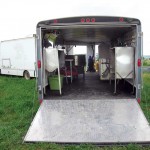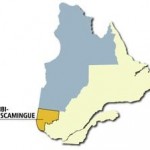Mobile Abattoirs: Lessons from Quebec
Posted: April 21, 2013
Categories: economic development / Food Processing / GoodFoodBites / Local Procurement / News from Sustain Ontario / The Meat Press
The troubles of butchers and slaughterhouse operators aren’t the most talked about of all the challenges facing food purveyors. It’s easy to support farmers growing kale or tomatoes, but dealing with questions of animal slaughter means entering into more murky territory, as not everyone agrees that we ought to eat meat and some of those who do would rather not think about the origins of their chicken or beef. But the challenges these folks are facing are getting quite severe; in fact, there’s been an almost 50% reduction in the number of facilities in Ontario since 1998, and so finally, more people are starting to take notice of this important link in local food chains. (If the lack of small /medium-sized, provincially-regulated, multi-species abattoirs in Ontario is news to you, read this).
Mobile abattoirs are becoming a talked-about potential solution to these problems. They offer the obvious advantage of being able to move around (after all, they’re transport trucks or trailers fitted with an impressive custom-designed interior that includes cutting and cooling rooms and meets all requisite food safety standards), and can set up on farms or community docking stations that are geographically dispersed. They also eliminate the need for animals to do the travelling, – a very stressful but often unavoidable affair – which is great news for anyone concerned with ethics in the raising of livestock or looking for consistently high quality meat. Finally, mobile abattoirs are generally cheaper to build and put in operation than regular permanent abattoirs.
Mobile abattoirs already operate on a limited basis in BC, Alberta and the Yukon, as well as in numerous US states, including many in rural New England. But it can be difficult to set these abattoirs up and operate them at a profit, so we ought to be careful as we consider them in Ontario’s context.
When and where do these abattoirs really work, and what allows them to succeed? The flip side of this question, of course, is “when don’t they work, and what can go wrong?” In trying to answer these questions, we can turn to a mobile abattoir that was set up in the region of Abitibi-Témiscamingue in Quebec, seven hours north of Montreal, which closed after just three years of operation.
The Short Life of the Abitibi-Témiscamingue Abattoir
This abattoir – the first provincially certified mobile red meat abattoir to operate east of Alberta – was in business from July 2005 to June 2008. It slaughtered a variety of animals including deer, goats, pigs, and sheep as well as rare animals like ostrich and emu and transported them to a processing facility called Au Grenier des Saveurs in the town of Val D’Or. This region is huge – it encompasses 57,000 km2 – and is north-west of highly-populated Southeastern Quebec, about 650 km from Montreal. As in many parts of Northern and rural Canada, the unemployment rate is rather high (9.6% compared to Quebec’s 8.5% in 2009)[1] and out-migration is a persistent concern. Most people find jobs in the mining, agriculture, forestry, and service sectors.
The mobile abattoir was started because there was a total lack of animal processing infrastructure in the region. Producers were sending animals incredible distances to southern abattoirs. The issues associated with so much travel are well-established. Not only does the farmer have to pay for multiple long drives (to drop off the animals and pick up the frozen meat about a week later), but the animals also suffer more in proportion to the length of the journey. Sometimes, and it’s been indicated this happens often to meat from this region, ‘dark cutting’ can result due to the stress-induced mobilization of muscle glycerin in an animal. This makes the meat dark in colour and unsellable, damaging producers’ bottom lines.[2]
It’s easy to see why building a moveable abattoir would seem like a good idea in Abitibi. These units can travel around large regions serving many dispersed producers, presumably enabling these small farms to succeed and allowing for the agricultural sector to grow in the region. Therefore, under the banner of regional rural development, it was decided that a mobile abattoir would be set up.
Several partners came together to this end, including the provincial agriculture ministry (le ministère de l’Agriculture, des Pêcheries et de l’Alimentation) and the federal government by way of the Canada Economic Development Fund, who together covered a portion of the associated start-up costs amounting to a total of $ 480,320. The project was led by a group of local producers and processors. Three permanent docking sites were set up within the region and the slaughtered/cooled carcasses were transported to a butcher shop in Val D’Or for further processing. In 2008, the mobile abattoir went bankrupt and closed permanently.
The biggest problem was that farmers just weren’t using the abattoir enough; it wasn’t operating at capacity. At first, about 20-25 producers were engaged, but this number was much lower by 2008 as they slowly became disenfranchised with the project. This wasn’t a result of the cost of slaughter services, as they were slaughtering at a rate equivalent to that of a permanent abattoir and were charging a comparable amount. In fact, the prices offered by the abattoir were very competitive, especially considering the money that producers saved by not transporting their animals long distances. Instead, the lack of use was probably due to two things: location-related politics the arose becuase farmers in some parts of the larger region felt improperly served, and the fact that farmers had trouble selling enough of the meat that they produced.
These location-based problems are rooted in the difficulties of serving a region of such sheer size. For example, if there weren’t enough animals to make a slaughter day at one of the docking sites worthwhile, a producer in that area would have to transport his/her animals to another site – sometimes 500 km away! Tensions developed and some producers dropped out. Plus, there were other producers who were simply skeptical of the project and continued to go outside of the region to have their animals slaughtered.
Secondly, farmers were having trouble selling enough beef locally. Livestock, especially beef cattle, does figure prominently into the region’s agriculture, cattle operations representing about 50% of the regions’ 715 farms.[3] But most of these producers do not market their own meat; they sell them into conventional markets. When the mobile abattoir opened, there was no parallel initiative to foster new markets for local meats, nor was any collective marketing strategy set up.
Producers were left to market their own meat – and did so, to some extent, through local butcher shops and restaurants, as well as at the farm-gate, but many others didn’t have the capacity to develop new markets. To be sure, Abitibi-Teminscamingue does appear to be a challenging place to market local meat, given its low population density and lower than average income levels. But who knows what would have been possible had some attention been given to this part of the puzzle!
What was Missing??
Leading up to the implementation of the project a business plan was developed by the Economic Development Society of Val d’Or, but a feasibility or market study was not undertaken. Some say this omission was the downfall of the mobile abattoir because it meant that the project began without an eye to the demand for local meat in the region. Others point to insufficient buy-in from the provincial and federal governments who, some say, were not as supportive of the project as they could have been. Others indicate that a lack of flexibility around regulations made things very difficult for the abattoir operators. For instance, water testing requirements were very hard to do in the mandated way during the winter, as samples kept freezing on the way from the docking stations to the processing locations, and there was not a lot of flexibility on this matter.
It’s also important to remember the geographic location of the region when considering it’s challenges, namely that it’s close to the Ontario border. It would make sense for some livestock producers in Abitibi-Témiscamingue to have their meat processed in Ontario and then sell it to their neighbours, a method that used to be possible before current regulations came into effect. But since provincially-inspected meats can no longer cross provincial borders this sort of arrangement is no longer a viable option. Not surprisingly, growers living near other provincial borders have to contend with similar problems. For example, in 2011 a Manitoba man pleaded guilty to selling some chickens across the Ontario border.[4] Officials have discussed the possibility of establishing an area in Northeastern Ontario/Northwestern Quebec in which meat could move more freely, and we have seen a promising development here just a few days ago. On April 6th a study was released which identified several possible scenarios for a regional abattoir that could serve communities on both sides of the border, and the leading proposal is for a small, federally inspected facility. Keep an eye out to see how this develops! [5]
In the meantime, what lessons can we take from this attempt to establish a mobile abattoir? First, the Abitibi-Témiscamingue abattoir project was made possible due to government financial support. It seems that if unit building costs are paid for, allowing the business to begin reasonably debt-free, getting a mobile abattoir project off the ground is much easier. But there’s clearly more to it! Regional demand for local meat needs to be considered and if that appears as though it will be a challenge for producers, there must be concerted effort to foster new markets alongside efforts to increase processing capacity.
 Third, it’s worth considering whether there are enough farmers willing to buy into the project to allow the abattoir to meet its costs and make a profit. It can be a challenge convincing farmers that different methods of processing and/or marketing their livestock, which can include mobile abattoirs, have the potential to serve them well. Often for good reason farmers are often weary of changing the methods they’ve been using for years. Plus, it needs to be established beforehand how often and under what conditions (number of animals to be processed, for example) the abattoir will visit a particular docking station. Clearly, it’s also really important to plan to address as many technical challenges beforehand as possible.
Third, it’s worth considering whether there are enough farmers willing to buy into the project to allow the abattoir to meet its costs and make a profit. It can be a challenge convincing farmers that different methods of processing and/or marketing their livestock, which can include mobile abattoirs, have the potential to serve them well. Often for good reason farmers are often weary of changing the methods they’ve been using for years. Plus, it needs to be established beforehand how often and under what conditions (number of animals to be processed, for example) the abattoir will visit a particular docking station. Clearly, it’s also really important to plan to address as many technical challenges beforehand as possible.
There are many resources that can help those designing and building units to address these challenges. The Niche Meat Processor Assistance Network is a great place to access information about mobile units. As more units keep popping up, more expertise is being developed and people are learning how to avoid many different kinds of problems. People in BC, the Yukon and Alberta likely have many lessons of their own to share!
Let’s take the lessons of Abitibi-Témiscamingue to heart, but let’s also keep in mind that there are a lots of mobile abattoir success stories to consider alongside this one! Let’s keep the conversation going.
[1] Abitibi-Témiscamingue (08) Region – Socioeconomic Profile
http://www.dec-ced.gc.ca/eng/publications/economic/profile/abitibi-temiscamingue/206/index.html
[2] Dark Cutting Beef – What is it? http://www.dpi.nsw.gov.au/agriculture/livestock/beef/market/publications/dcb
[3] L’union des producteurs agricoles, Abitibi-Temiscamingue. http://www.upa.qc.ca/en/Who_we_are/Regions/Abitibi-Temiscamingue.html
[4] Poultry Abattoir Proposed for Thunder Bay. http://www.betterfarming.com/online-news/poultry-abattoir-proposed-thunder-bay-492
[5] Trois scénarios retenus pour la création d’un abattoir régional
http://www.radio-canada.ca/regions/abitibi/2013/04/06/002-abattoir-etude-regional.shtml



